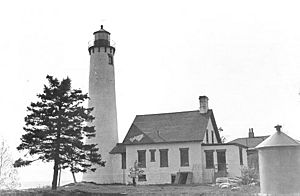Poverty Island Light Station facts for kids
 |
|
|
|
|
| Location | On Poverty Island in NW Lake Michigan, 5.8 miles (9.3 km) south of the Garden Peninsula |
|---|---|
| Coordinates | 45°31′38″N 86°39′49″W / 45.52722°N 86.66361°W |
| Year first constructed | 1875 |
| Year first lit | 1875 |
| Automated | 1957 |
| Deactivated | 1976 |
| Foundation | dressed stone |
| Construction | brick |
| Tower shape | conical |
| Markings / pattern | white |
| Height | 65 feet (20 m) |
| Focal height | 78 feet (24 m) |
| Original lens | fourth order Fresnel lens |
| Range | 14 nautical miles; 26 kilometres (16 mi) |
The Poverty Island Light is a historic lighthouse. You can find it on Poverty Island in the northwest part of Lake Michigan. It's about 5.8 miles south of the Garden Peninsula. This lighthouse was added to the National Register of Historic Places in 2005. It is officially known as the Poverty Island Light Station.
Contents
History of the Poverty Island Light
Why a Lighthouse Was Needed
In 1864, a new railroad line was finished. It connected Escanaba and Negaunee. This made it easy to move iron ore to the southern shore of the Upper Peninsula.
Because of this, many more ships started sailing into Escanaba. These ships often passed through the Poverty Island Passage. This passage was quite narrow and dangerous to navigate at night.
To make shipping safer, the Lighthouse Board asked for money in 1867. They wanted to build a lighthouse on the southern tip of Poverty Island.
Building the Lighthouse
It took a few years for the money to be approved. Finally, in 1873, Congress provided $18,000 for the lighthouse. Work began that same year.
However, a fire late in the season destroyed some building materials. Work continued in 1874, but the tower was not fully finished. A temporary light was put in place. After another $3,000 was given, the entire light station was completed in 1875. The permanent light, with its special Fresnel lens, was first lit on August 10, 1875.
Changes Over Time
Over the years, more buildings were added to the light station. In 1885, a fog signal station was built nearby. This helped ships navigate in foggy weather. In 1894, an iron oil house was constructed. Docks were also built to make it easier to deliver supplies.
The lighthouse became automated in 1957. This meant keepers no longer had to live there. The buildings were then left empty. In 1976, the light was turned off for good. A new light was placed on a steel tower nearby.
What Happened to the Lantern?
When the lighthouse was deactivated, its cast iron lantern was taken off the tower. It was left nearby with other old equipment. In the 1980s, the Delta County Historical Society found the lantern. They rescued it and used it to fix up the Sand Point Light in Escanaba.
The Poverty Island Light remains abandoned today. In 2011, Lighthouse Digest magazine called it "America’s Most Endangered Lighthouse."
About the Lighthouse Building
The Poverty Island Light was designed to look very similar to the Sturgeon Point Light. The tower stands about 70 feet tall. The light itself was placed in a cast iron lantern. This lantern was about 65 feet above the ground. A building for the lighthouse keeper, made of wood and brick, is attached to the tower.


